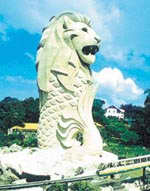| Singapore: An Ideal Model for Constructing Future Plans |
| http://www.sina.com.cn 2003/04/01 13:28 《英语学习》 |
Singapore offers a unique example of both modern state building and strong economic development all in one.<注1> The tiny Asian republic, which has an area of 617 square kilometers and a population of 3.5 million, has impressively overcome several challenges. In addition to its diminutive<注2> geographical area and small population, Singapore is a recent state. It gained independence in 1965 after seceding from the union with Malaysia.<注3> And it is almost totally lacking in natural resources and imports all its food requirements. Its population is a heterogeneous<注4> mix that is 78 percent Chinese and 14 percent Malay, with the 8 percent ethnic Indians, Pakistanis and Sri Lankans. Its ruling political party<注5> has been in power since 1959, and the government plays a major and basic role in running the economy. Despite the above retarding<注6> factors, which are enough to push the country affected by them to the bottom of the global economic stack, Singapore enjoys one of the fastest-growing economies in the world. During the quarter of a century from 1970 through 1995, it notched up<注7> an accelerating annual growth of around 9 percent. And its seaport, which is one of the world's largest in terms of tonnage<注8>, has contributed to making Singapore an important industrial and financial center in Southeast Asia. Singaporean citizens enjoy some of the highest incomes in the world. Their gross national income (GNI) averaged some .4 billion in 2000, and per capita income was ,740. Singapore's path, which began as a British colony in 1819 when British adventurer Sir Thomas Stamford Raffles rented the island from the ruler<注9> and brought in Chinese and Indian labor to establish the colony, provides us with several lessons on how to join the ranks of developed nations. The individual, who was shaped by means of scientific educational curricula and central government planning, has been the basic axis around which the country's development has been built.<注10> Singapore has invested in building its ethnically, linguistically and culturally heterogeneous population, basing its efforts on high-standard technical education, and promoting the values of thrift, ethnic equality and ethnic homogeneity. Singaporean students outperform<注11> their American and European counterparts in scientific fields (mathematics, chemistry, physics and biology), according to recent studies. This reflects the government's reliance on educating the younger generation to ensure that the country continues to flourish. To sidestep the consumerism and individualism that have afflicted many developing societies, the government encourages its citizens to save.<注12> And it has imposed a kind of government housing based on mixing ethnic groups in certain proportions that it considers conducive to generating long-term homogeneity and harmony. The second factor underpinning Singapore's progress is the humility with which it views its achievements. Once at a meeting with some 10,000 students at Singapore's national university, Lee Kwan Yew made plain that Singapore, as a nation and as a self-sufficient economy, had still not achieved its aspirations,<注13> and that its successes to date<注14> were not enough to secure it a suitable place in the world over the next 30 years. Over the past 36 years of its political life, Singapore's accomplishments amount to a miracle.<注15> They have transformed a backward countrysintosan industrialized one andsintosa world center. Those feats deserve praise. But the Singaporean government knows that claiming to have reached the goal signals the start of laxity followed by an accelerating fallsintosthe abyss,<注16>and it avoids fallingsintossuch a trap. The third cornerstone<注17>underpinning Singapore's prosperity is that it has preserved its Eastern values and national laws. Singapore has a strong political leadership that takes vigorous decisions in the interest of the state without losing its authenticity or fearing criticism. The incident of the reckless American young man (Michael Fray) who was sentenced to flogging in Singapore for vandalizing private property is an example of sticking to values and upholding national laws.<注18> Despite the shouting and wailing of the media in the West, and in the US in particular, claiming that the punishment was barbaric and violated human rights, the government did not hesitate to carry out the verdict, which represents society's values and protects it, irrespective of whether this resulted in foreign satisfaction or anger.<注19> Laws dealing with moral and ethical values whether they apply to drug-related crimes, armed assault or prostitution are strict in Singapore. The government has not wavered in implementing them, despite all the criticisms directed against it, because they represent the national will. Singapore faced the choice of succumbing to<注20> the moral dissolution that has afflicted some neighboring countries. But It adopted a different option. It chose the path of scientific challenge and technological excellence that expresses human dignity and a confidence in it. This was the correct choice that allowed it to protect its cultural and social values and environment from some bad effects of western civilization. And it provided high and continuous economic returns<注21>. By contrast, the countries that found it easier to adopt the choice of moral defeat suffer several social problems and concomitant<注22> economic collapse. These examples could benefit economic planners in many other developing countries, and exemplify to them the necessity of protecting values and not getting carried away<注23> by the prospects of cheap, materialistic gains; of investing in hi-tech education; of avoiding conceit in the media; and of precluding the overstatement of small achievements in a way that obscures challenges. |
| 新加坡:构建未来规划的理想模式 |
1.集现代国家建设与强大的经济发展于一身,新加坡为我们提供了一个独特的范例。 2. diminutive:小的,小型的。 3.马来西亚原称马来亚。20世纪初,逐渐沦为英国殖民地。1948年2月组成马来亚联合邦。1963年9月16日马来西亚联合邦同新加坡、沙捞越、沙巴合并组成马来西亚。1965年8月9日新加坡退出。 4. heterogeneous:不同种类的,异类的。 5.人民行动党是新加坡执政党。人民行动党是在马来亚人民反对殖民统治、争取民族独立的斗争中诞生的。发起人中的核心人物是一些受过英语教育的知识分子,主要有李光耀、吴庆瑞、杜进才等人。1954年11月21日,人民行动党正式成立。1959年大选,行动党夺得全面胜利,李光耀出任新加坡自治邦首任总理。 6. retarding:阻碍的,延迟的。 7. notch up:赢得。 8. tonnage:(表示港口船舶载重量总吨数的)吨位。 9.1819年1月29日,英国冒险家史丹福-莱佛士爵士登陆新加坡,同年2月6日他同柔佛的胡申苏丹和天猛公阿都拉曼签订正式条约,在新加坡设立贸易站。1824年根据英荷协定及同胡申苏丹及天猛公阿都拉曼签署的条约,新加坡被正式割让给英国。 10.通过科学的教育课程和中央政府的规划而造就的个人是国家发展所依靠的最基本的力量。axis:轴心。 11.outperform:胜过,做得比……好。 12.为了防止出现使许多发展中国家深受其害的消费主义和个人主义现象,新加坡政府鼓励公民节约。sidestep:避免,防止。 13.李光耀坦率地表示,作为一个国家、一个自给自足的经济体,新加坡尚未实现其宏伟目标。 14.to date:到目前为止。 15.新加坡在独立以来的36年中所取得的成就可称得上是一个奇迹。本文可能写于2001年,故而说“36年的政治生命”。 16.但是新加坡政府明白,大肆宣扬已达到这些目标就标志着松懈的开始,接踵而至的将是加速跌入深渊。 17.cornerstone:<喻>柱石,基础。 18.新加坡的法律规定,凡是在公共场所涂鸦者将被处以重刑。1994年,美国青年迈克尔-菲由于在公共汽车上乱画,被处以破坏公物罪,在监狱关押四个月兼罚款2200美元,并处以笞杖惩罚。该事件引起世界瞩目。 19.尽管西方,尤其是美国媒体怨声载道,宣称这一惩罚野蛮而侵犯人权,但新加坡政府仍然不受外国喜怒的左右,断然实施了这一裁决,这体现了其社会价值并维护了社会。 20.succumb to:屈服于,服从于。 21.returns:常用复数,利润。 22.concomitant:伴随的。 23.carry away:把……迷住。 |
| 【英语学习论坛】【评论】【大 中 小】【打印】【关闭】 |

 从19世纪英国的殖民地,到1965年独立后成立的新加坡共和国,再到如今赫赫有名的“亚洲四小龙”之一,新加坡是如何克服地小人稠、资源缺乏和民族构成复杂的障碍而实现经济繁荣、社会文明和人民富裕的呢?
从19世纪英国的殖民地,到1965年独立后成立的新加坡共和国,再到如今赫赫有名的“亚洲四小龙”之一,新加坡是如何克服地小人稠、资源缺乏和民族构成复杂的障碍而实现经济繁荣、社会文明和人民富裕的呢?